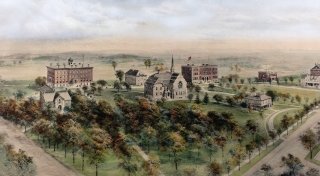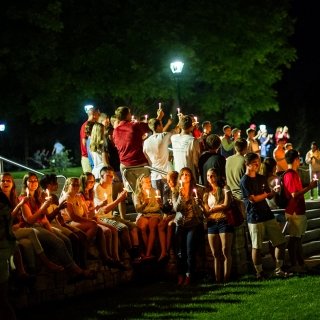
Mission and History
Our Mission
The mission of St. Lawrence University is to provide an inspiring and demanding undergraduate education in the liberal arts to students selected for their seriousness of purpose and intellectual promise.
University History
In the mid-1850s, four members of the Universalist Church ventured from St. Lawrence County in pursuit of establishing a 20-acre campus and a new building in the county seat. Armed with $9,000 in pledges from nearly 150 community members, they set out to persuade decision-makers in Syracuse that Canton should be the new home of a theological school with a college of letters and sciences alongside it. They knew the world needed St. Lawrence and, after much debate and deliberation, their dream came true: ‘The St. Lawrence University’ was chartered by the State of New York on April 3, 1856, as a Universalist seminary and college of letters and science.
St. Lawrence, the oldest coeducational institution of higher learning in New York State and home to one of the oldest environmental studies programs in the country, has championed progressive ideas such as critical thinking, sustainability, and a commitment to equity and inclusion since its founding day. The history of the Laurentian community is that of industry pioneers, renowned authors and astronomers, government leaders, movie stars, and sports legends.
Yet the history of this space in the North Country includes stories and accomplishments from others who came long before the University was chartered. St. Lawrence University occupies the traditional lands of the Haudenosaunee (the People of the Longhouse)/Iroquois Confederacy. The United States is granted continued claim to this territory by the confederated nations (Kanienʼkehá꞉ka “the People of the Flint”/Mohawk, Onyota'a:ka “the People of the Upright Stone”/Oneida, Onondagaono “the Hill Place People”/Onondaga, Gayogo̱hó꞉nǫʼ “the People of the Great Swamp”/Cayuga, Onongawaga “the People of the Great Hill”/Seneca, and Skarureh “the People of the Hemp”/Tuscarora) through a diplomatic relationship beginning with the Canandaigua Treaty of 1794.
From the Archives
- 1856: St. Lawrence University is chartered as a Universalist seminary and college of letters and science. The University becomes the oldest continuously coeducational institution of higher learning in New York State.
- 1863: Olympia Brown is the first woman to graduate from St. Lawrence’s theological school. She later becomes the first woman to be ordained and achieve full ministerial standing recognized by a denomination (Universalists).
- 1863: The Thelomathesian Society is formed as a debating and literary society. In 1894, the club is abolished in favor of incorporating all students into the organization, creating the University’s student government.
- 1865: Mary Herrick and Sarah Sprague are the first women to graduate from what was then the University’s College of Letters and Sciences.
- 1869: One of St. Lawrence’s oldest traditions, “Tree Holiday”, begins, giving students a day off of classes to transplant trees to campus. The tradition morphs into what is today known as Moving-up Day.
- 1876: Scarlet and brown are adopted as the school colors.
- 1888: St. Lawrence’s first intercollegiate sports team—baseball—forms.
- 1899: Amin Beder is the first student from overseas (modern-day Lebanon) to graduate from St. Lawrence.
- 1900: Eben Holden, a novel by Irving Bacheller, Class of 1882, is an instant hit and is America’s first best-selling novel of the 20th century.
- 1903: St. Lawrence’s first women’s sports team—basketball—forms.
- 1911: The Hill News, St. Lawrence’s student newspaper, is published for the first time.
- Early 1920s: One of the first college radio stations in the country was founded in a pig barn on campus by the physics department.
- 1924: J. Kimball Gannon, Class of 1924, writes “Alma Mater.” In 1950, it’s added to the “Songs of St. Lawrence” book, along with “A Tribute” by John Brush, Class of 1922, and “Chapel Bells” by Eugene Wright, Class of 1949. Together, these songs form the traditional St. Lawrence songs.
- 1926: The Bacheller Memorial Chime is donated to St. Lawrence University by Irving Bacheller, Class of 1882. Today, the bells ring every weekday during the academic year at 5 p.m.
- 1929: Nobel Prize-winning chemist Madame Marie Curie is the keynote speaker at the dedication of Hepburn Hall.
- 1929: Owen D. Young, Class of 1894, is named TIME Magazine’s Man of the Year.
- 1933: Jeffrey Campbell is the first African American graduate of St. Lawrence. In 1935, he becomes the first Black Laurentian to be ordained as a Universalist minister by St. Lawrence’s theological school.
- 1937: The Outing Club is founded, becoming the second oldest in the country behind Dartmouth College.
- 1950: St. Lawrence’s men’s basketball team defeats the NBA’s Syracuse Nationals, 69-67.
- 1951: The men’s hockey team hosts its first game in Appleton Arena.
- 1964: St. Lawrence’s inaugural international study program begins in France.
- 1965: St. Lawrence’s theological school closes.
- 1965: The University acquires the first unit of what is now known as the Canaras Conference Center in Upper Saranac Lake.
- 1969: Higher Education Opportunity Program welcomes its first class.
- 1974: The University’s original building, Richardson Hall, and Herring-Cole Hall are listed on the National Register of Historic Places.
- 1978: “International House,” one of St. Lawrence’s oldest theme communities and known on campus as “I-House”, opens for the first time.
- 1982: Students embark on the first ever Peak Weekend, originally dubbed “46er Day.”
- 1984: Structures built on campus before 1930 are listed on the National Register of Historic Places as “St. Lawrence University-Old Campus Historic District.”
- 1987: St. Lawrence pilots the First-Year Program, one of the oldest living-learning programs in the country.
- 1993: The Java Barn opens. Today it’s still one of the only student-run college music venues in the country.
- 2007: Johnson Hall of Science opens. It is New York State’s first LEED gold-certified building.
- 2021: The Campaign for Every Laurentian raises $230 million, making it the largest fundraising effort in University history.

Traditions and Special Events
"We have lit a candle in the wilderness that will never be extinguished.” Learn more about our history and the traditions and events that Laurentians treasure most.
